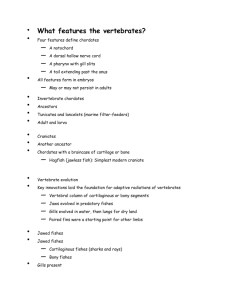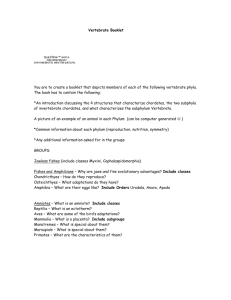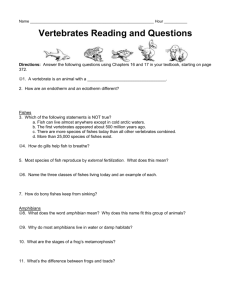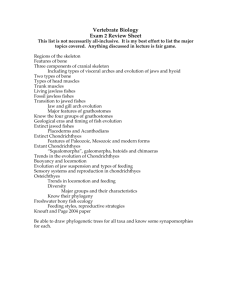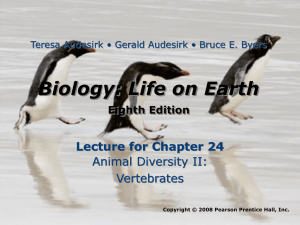Chapter 26 chordates - Doral Academy Preparatory
advertisement
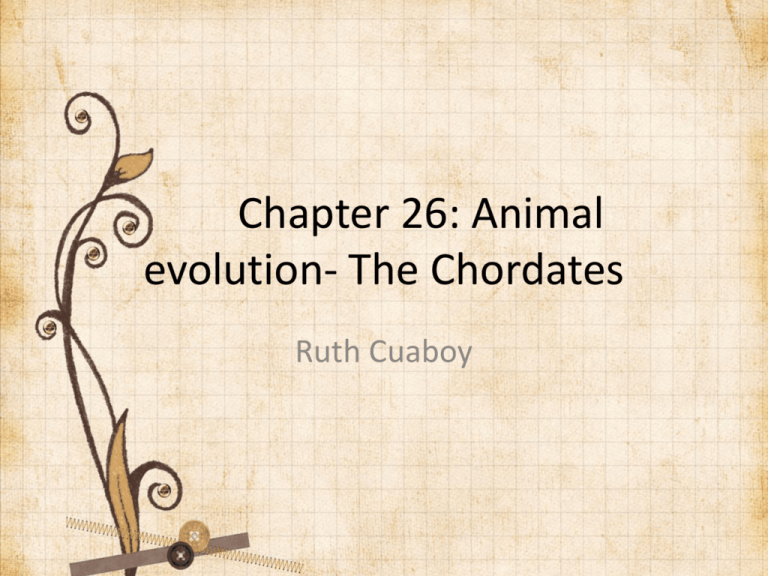
Chapter 26: Animal evolution- The Chordates Ruth Cuaboy Characteristics of Chordates 1. Notochord; connective tissue extending along body. To provide support. 2. Dorsal: Nerve cord. 3. Gill slits: along the throat(pharynx) 4. Muscular tail: extending tail beyond the anus. Invertebrate Chordates Lancelets (subphylum cephalochordata); They miss a brain case , and paired sensory organs. They filter food from water and their cilia allows them to move. There segmented muscles allow them to swim short distances. Tunicates(subphylum urochordata); Are larvae with chordate traits. The only characteristics they end up from chordates are the pharynx and the gill slits. Tunicates also filter food from water. The water enters through their mouth its passes through he slits and sticks to the mucus and gets sent to the gut. Craniates; have brain case to support the brain. Have paired eyes and sensory structures in the head. For example the hagfish has a notochord which supports the body, have paired eyes that detect vibrations. Use vibrations the most since their vision is poor. Lancelet hagfish Tunicate Vertebrate evolution Amphibians Major classes of vertebrates Jawless lampreys: Larval lampreys ;have no jaws or fins. Have a backbone of cartilage. They all undergo metamorphosis. They burrow into the sediments and filter food from the water. Parasitic lamprey; have an oral disk. They attach to the host and the host later dies of blood loss or infection. Most remain in fresh water and the parasitic lampreys migrate to sea. Jawed fishes Jawed fishes; have paired fins and scales. Hard structures grow and cover the skin. Two groups of jawed fishes 1. Cartilaginous fishes; all have a skeleton of cartilage and gill slits. teeth are modified scales that harden. Ex; marine sharks and rays. Bony fishes Bony fishes; Bones replace cartilage. Have an operculum which is a cover that protects the gills. Have a swim bladder which is a gas filled device that adjusts the volume of gas which enables the fish to be in water at different depths. Subgroups: 1. Ray finned fishes; Have flexible fin support derived from skin. Are the most diverse fishes. ex: teleosts , sea horses Lung fishes; bony fishes that have gills and lung like sacs. They have outpouchings of the gut wall. They fill the sacs by gulping air and the oxygen diffuses from sacs to blood. Coelacanths; there ventral fins are fleshy extensions of the body wall. Are a modern group of lobe finned fishes. Early primates Amphibians • Need water to breed and have 3 chanber hearts. •Branched off the lobe finned fishes. •Adapted to swimming into four legged walkers(tetrapods). •Division in the heart to two circuits one to body and the other to lungs. •Modern amphibians: salamanders, caelians,, frogs/toads. salamander; walk with body bent like a swimming fish which means ancestors had the same way of walking. Caecilians; burrow through soil and use touch and smell to catch prey. Frogs/toads; elongated hind legs for leaps and swimming. Cenozoic era Starts off with amniotes. They make eggs having four membranes that allows embryos to develop away from water. Also had waterproof skin and kidneys. 3 remaining groups; turtles, lizards/snakes, crocodiles/birds. Reptile: No traits of birds or mammals. Early reptiles; lizard like body and waterproof scales. Dinosaurs; configurations of pelvis and hips. Birds; •Scales of group of a dinosaur which became feathers and descended into birds. •Birds produce eggs and are also endotherms which is maintaining body temperature. • The wings came from modified fore limbs with feathers extended outward. •Has four chamber heart. Sinosauropteryx prima Confuciusornis sanctus Mammals • • • Have hair or fur that were modifications of scales. Have four different types of teeth (incisors) in order tear and rip. Having this allows them to eat a variety of foods. Hominoids/Hominids • • Hominoids; include apes and humans. Hominids; human and extinct human like species. > due to climate changes it became it difficult to find food. Most ended up dying out. proconsul aficanus Diversity in mammals 1) *Egg-laying Mammals or Monotremes (platypus) (2) *Pouched Mammals or Marsupials (opossums, kangaroos) Metatheria) (3) *Placental mammals ( manatee) Australopiths Genus Homo • • • • • Fossil teeth indcated huimans ate hard shelled nuts,seeds,and leaves. • Close relatives are chimpanzees and bonobos. • They did the same as hominids did. Were very petite Narrow jaw Small teeth Ancestral to modern humans. australopithecus africanus
